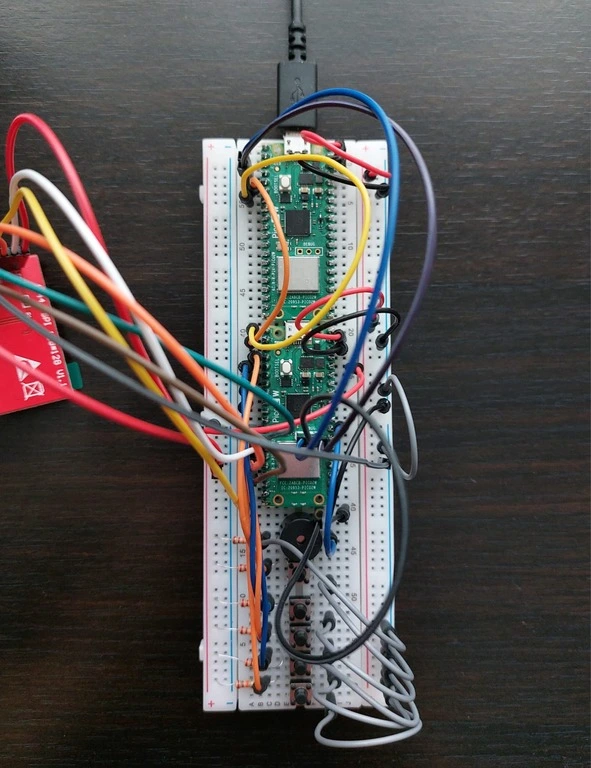2048 game
Implementation of the famous game 2048.
Author: Diaconu Alexandra-Ioana
GitHub Project Link: https://github.com/UPB-PMRust-Students/proiect-AlexDia10
Description
The project consists of an implementation of the famous game 2048. The goal of the game is to reach the value 2048 by combining powers of 2 on a 4x4 board (classic mode). The player combines numbered tiles by moving up, down, left and right, using physical buttons. The game runs on a Raspberry Pi Pico 2 and is displayed on a color LCD.
-
The system utilizes five buttons for the gameplay: up, down, left, right and reset.
-
The LCD screen showcases the grid and the numbered tiles.
-
A buzzer that makes a sound when a milestone is reached.
Motivation
As a kid, I loved playing simple, clever games like 2048, fascinated by how such a basic concept could be so addictive and satisfying. That experience stuck with me and inspired this project: building my own version of 2048 from scratch.
While planning the system — from managing inputs to handling graphics and game logic — I realized it’s more than just code. It’s also about creating a smooth, engaging experience, which taps into my love for design and user interaction.
Architecture
The Raspberry Pi Pico 2W serves as the central control unit, directing and managing all other components utilized within the project.
The LCD serves as an interface for showcasing the grid and numbered tiles, it is connected to the Pico through SPI
The buttons act as the primary input method, they are connected directly to the Pico's GPIO pins
The buzzer emits sound cues for actions and is connected to a GPIO pin
Log
Week 5–11 May
Conducted individual testing of all hardware components to ensure functionality and reliability.
Week 12–18 May
Finalized and verified all hardware connections.
Performed integrated testing of all components working together.
Initiated development of the core game logic.
Updated project documentation to reflect the final hardware schematic.
Week 19–25 May
Achieved significant progress in implementing the game logic.
Identified and resolved several logic-related issues.
Enhanced documentation by including a list and explanation of the libraries utilized in the project.
Hardware
- Raspberry Pi Pico 2W:
- Purpose: Controls all components.
- Function: Acts as the main controller, coordinating the operations of buttons, buzzer, and the LCD display.
- LCD Display:
- Purpose: Displays the grid and numbered tiles of the 2048 game.
- Function: Provides a visual interface for the user, updating the display dynamically as the user moves the tiles and merges them.
- Buttons:
- Purpose: Serve as the user input method for controlling the game.
- Function: Allow the player to move tiles in four directions (Up, Down, Left, Right) and reset the game.
- Buzzer:
- Purpose: Provide auditory feedback during gameplay.
- Function: Emits sound cues for actions such as tile merges, successful moves, or game over.


Schematics
Bill of Materials
| Device | Usage | Price |
|---|---|---|
| Raspberry Pi Pico 2W | The microcontroller | 39,66 RON |
| LCD Display | LCD Display | 27,99 RON |
| Buttons | Push Buttons | 5 x 0,36 RON |
| Buzzer | Active Buzzer | 0,99 RON |
Software
| Library | Description | Usage |
|---|---|---|
| embassy-executor | Async executor for embedded systems | Spawns and runs async tasks (Spawner) |
| embassy-time | Time and delay utilities for async embedded apps | Used for Delay, Timer, and Duration utilities |
| embassy-sync | Async synchronization primitives | Provides Mutex and Channel for safe inter-task communication |
| embassy-rp | Embassy driver support for RP2040 | Provides GPIO and SPI peripheral access (gpio::Output, spi::Spi) |
| embassy-embedded-hal | Hardware abstraction traits for embedded devices | Provides SpiDevice trait for shared SPI interface |
| display-interface-spi | Wrapper to convert SPI interfaces to display interfaces | Adapts SPI bus to a display driver interface |
| mipidsi | Driver for MIPI DSI compatible displays like ST7735 | Drives the ST7735 LCD over SPI (Builder, Orientation, etc.) |
| embedded-graphics | 2D graphics library for embedded devices | Renders text and shapes on the LCD (Text, Rectangle, Rgb565, etc.) |
| rand | Random number generator and utilities | Generates pseudo-random numbers via SmallRng |

